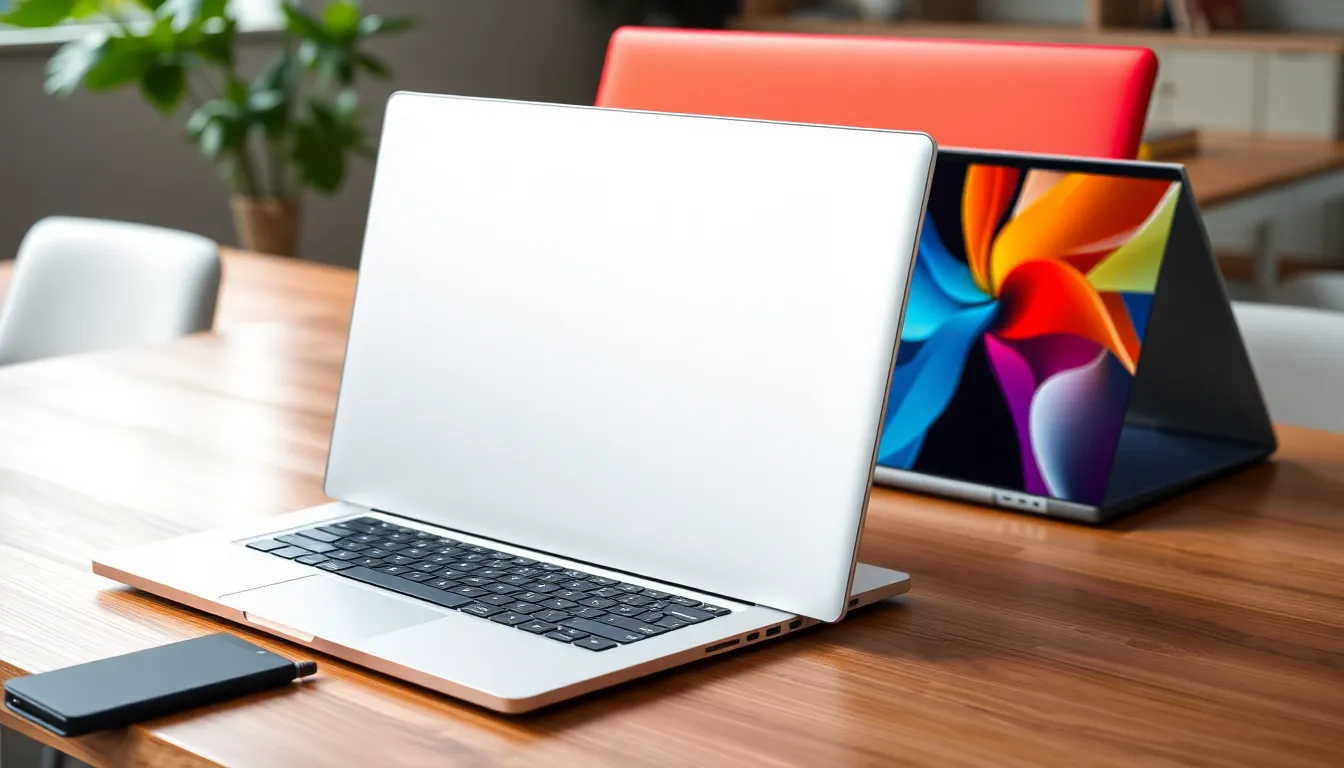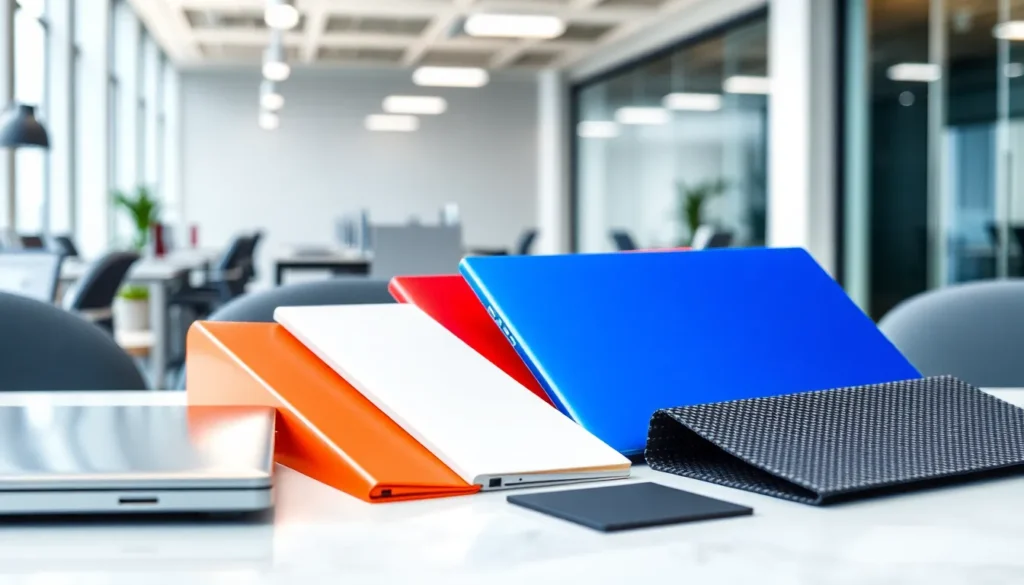Table of Contents
ToggleWhen it comes to laptops, the materials they’re made from can make or break the experience. Think of it like picking a sandwich: would you choose soggy bread, or something that can stand up to a little pressure? The right materials not only affect durability and weight but also impact performance and style.
From sleek aluminum to sturdy plastic, each material has its own quirks and benefits. Some scream sophistication while others are more about rugged reliability. Understanding these materials can help anyone make a savvy choice, ensuring they don’t end up with a laptop that feels like it belongs in a toddler’s art class. Dive into the world of laptop materials and discover what makes your tech tick—because who doesn’t want a laptop that’s as tough as it is stylish?
Overview of Laptop Materials
Laptop materials play a crucial role in overall performance and user satisfaction. Commonly used materials include aluminum, plastic, and magnesium. Each material comes with advantages and disadvantages worth considering.
Aluminum offers a sleek, modern look and considerable durability. It resists scratches and dents better than most alternatives. Many users appreciate its premium feel, which often enhances the laptop’s aesthetic appeal.
Plastic, on the other hand, usually reduces weight and production costs. Lightweight laptops tend to feature plastic, making them ideal for portability. However, less expensive plastic may compromise durability, though innovations in plastic quality are addressing such concerns.
Magnesium alloys combine strength and lightweight properties. These materials provide significant durability without adding bulk. Many manufacturers utilize magnesium in high-performance models, appealing to power users.
Carbon fiber stands out for its strength-to-weight ratio. While often more expensive, it delivers an ultra-lightweight and robust option. Working professionals frequently select carbon fiber for its premium aesthetics and performance benefits.
Choosing the right laptop material depends on personal preferences and intended usage. Regular commuters may prioritize weight over sturdiness, while gamers often seek heavy-duty materials that withstand wear. Enhancing user experience requires understanding the characteristics of each material to ensure it aligns with individual needs.
Common Laptop Materials

Understanding the common materials used in laptops helps consumers make informed choices regarding durability, weight, and performance.
Aluminum
Aluminum features prominently in many laptops due to its sleek appearance and robust durability. This material resists dents and scratches, making it ideal for daily use. It’s also lightweight, contributing to easier portability. Manufacturers often choose aluminum for premium models, associating it with quality. Additionally, aluminum can aid in heat dissipation, helping maintain optimal performance during heavy tasks.
Plastic
Plastic serves as a popular choice for budget-friendly laptops, thanks to its lightweight nature and lower manufacturing costs. Various colors and designs are available, enabling customizable aesthetics. However, plastic’s structural integrity might not match that of metals, sometimes leading to wear and tear with extended use. For casual users or students, plastic laptops provide an affordable option without significant performance loss. The ease of production allows for frequent updates to style and design.
Magnesium Alloy
Magnesium alloys combine strength and lightweight properties, appealing particularly to professionals and gamers. This material offers impressive durability while keeping the laptop’s weight manageable. Users appreciate the added resilience, making it suitable for travel and demanding environments. Magnesium is less likely to warp or bend under pressure, ensuring a longer lifespan for devices. Its premium feel often attracts those willing to invest in high-performance laptops.
Carbon Fiber
Carbon fiber stands out for its exceptional strength-to-weight ratio, making it a favored material among high-end laptop models. Many professionals opt for carbon fiber due to its lightweight yet sturdy design. This material exhibits excellent resistance to flex and stress, enhancing durability during frequent transport. Users benefit from its premium aesthetics, which convey sophistication and modernity. Additionally, carbon fiber can provide a better grip, adding to user comfort when handling the device.
Pros and Cons of Different Materials
Laptop materials significantly impact performance and user satisfaction. Assessing these materials helps buyers understand which fits their needs best.
Durability
Aluminum boasts impressive durability, resisting dents and scratches effectively. Plastic, while lightweight, tends to be less resistant to wear and tear over time. Magnesium alloys offer a nice balance, providing strength without considerable weight. Carbon fiber excels in durability with its exceptional strength-to-weight ratio. Each option presents various levels of durability, impacting longevity and usability.
Weight
Weight varies considerably across materials. Aluminum generally falls on the heavier side, providing strength but compromising portability. Plastic shines in the lightweight category, making it favorable for travel. Magnesium alloys maintain a lightweight profile while ensuring robust performance. Carbon fiber stands out as one of the lightest materials, appealing to users prioritizing mobility. Buyers should consider how weight influences their daily activities.
Heat Dissipation
Effective heat dissipation enhances laptop performance. Aluminum excels in this area, efficiently drawing heat away from internal components. Plastic may falter, often trapping heat and causing performance issues. Magnesium alloys provide decent heat management, balancing lightweight properties with thermal efficiency. Carbon fiber offers moderate heat dissipation capabilities while maintaining strength. Selecting materials for optimal heat management can lead to better device performance.
Aesthetics
Aesthetics play a vital role in materials selection. Aluminum presents a modern, sleek appearance that appeals to many users. Plastic offers customization options, allowing users to express personal style. Magnesium alloys possess a premium look, often favored by professionals. Carbon fiber features a contemporary design, attracting those seeking luxury. Visual appeal can significantly influence purchasing decisions, making it an essential factor.
Future Trends in Laptop Materials
Innovative materials are shaping the future of laptops. Biodegradable materials offer an eco-friendly alternative and promise to decrease electronic waste. Manufacturers are exploring options like plant-based plastics and recycled aluminum, aiming to enhance sustainability.
Nanotechnology is revolutionizing material applications as well. This technology promotes lighter, stronger, and more durable components, revolutionizing design possibilities. By integrating nanomaterials, laptops can achieve enhancements in performance and resilience.
3D printing is also emerging in laptop manufacturing. This method allows for customized designs and reduces material waste, catering to individual preferences and performance needs. Production efficiency gains are expected as this technology becomes more mainstream.
Graphene is gaining attention for its exceptional electrical and thermal conductivity alongside its light weight and strength. Incorporating graphene could lead to laptops that are faster and more efficient while also remaining portable.
Smart materials, such as phase change materials, adapt their properties based on environmental conditions. These materials regulate temperature in laptops, maintaining optimal performance during intensive tasks.
Collaborations between tech companies and material scientists are crucial for discovering and implementing these advancements. Continuous investment in research will drive material evolution.
Overall, trends in laptop materials signal a shift toward more sustainable, efficient, and high-performance designs, responding to user demands for both functionality and environmental consciousness.
Choosing the right laptop material is crucial for enhancing user experience. Each material offers unique benefits that cater to different needs and preferences. As technology advances, the emergence of innovative materials promises to further improve durability, performance, and sustainability.
Understanding these options empowers consumers to make informed decisions that align with their lifestyle and usage. From the sleek finish of aluminum to the lightweight nature of plastic and the premium feel of magnesium alloys and carbon fiber, the right choice can significantly impact satisfaction and functionality.
With ongoing research and development in the industry, the future of laptop materials looks promising. This evolution will likely lead to even more efficient and environmentally friendly options that will redefine how users interact with their devices.







